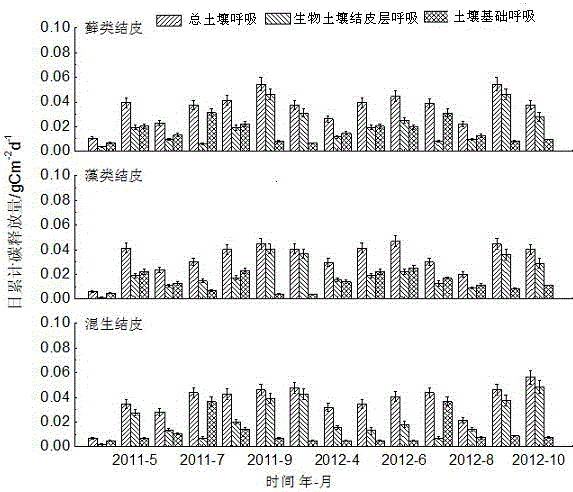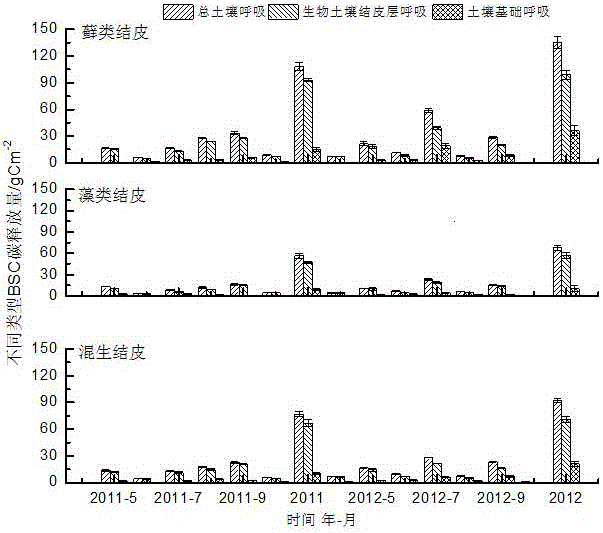A method for differentiating biological soil crusts from their subsoil basal respiration
A bio-soil and basic respiration technology, applied in soil material testing, material inspection products, etc., can solve the problem that the contribution rate of carbon release cannot be realized, and achieve the effect of accurate distinction, accuracy assurance, and thorough separation
- Summary
- Abstract
- Description
- Claims
- Application Information
AI Technical Summary
Problems solved by technology
Method used
Image
Examples
example 1
[0027] Example 1: Determination of soil respiration of different components of biological soil crust cover soil under dry conditions:
[0028]From April to October in 2011 and 2012, the soil respiration of different components of biological soil crust cover soil was measured under dry conditions. The method for measuring the diurnal variation of soil respiration under dry conditions is as follows. The diurnal variation is selected under the conditions of sunny weather, no rainfall, and the moisture content of 0-10cm soil mass < 5%. Measurements are carried out between 7:00-23:00, once every 2 hours; seasonal (spring, summer, autumn) change soil respiration calculation method, the method of cumulative calculation of each daily change soil respiration volume; annual average and inter-annual soil respiration Calculation, using the method of cumulative calculation of soil respiration in each season. Soil respiration rate was measured using a Li-6400-09 soil respiration chamber (L...
example 2
[0029] Example 2: Determination of soil respiration of different components of biological soil crust covering soil under wet conditions
[0030] From April to October in 2011 and 2012, the soil respiration of different components of biological soil crust cover soil was measured under humid conditions. The measurement method of soil respiration under wet conditions is as follows: when the rainfall is less than 3 mm, the observation is started immediately after the rainfall, and then every 2 hours, until the soil respiration rate returns to the level before the precipitation, the measurement is stopped. For rainfall > 3 mm, observations were started immediately after the end of the rainfall, and observations were made every day at 9:00, 11:00, 14:00, 17:00, and 20:00 until the soil respiration rate returned to the level before the precipitation, and the measurement was stopped. Soil respiration rate was measured using a Li-6400-09 soil respiration chamber (Li-COR, INC, US) to me...
PUM
 Login to View More
Login to View More Abstract
Description
Claims
Application Information
 Login to View More
Login to View More - R&D
- Intellectual Property
- Life Sciences
- Materials
- Tech Scout
- Unparalleled Data Quality
- Higher Quality Content
- 60% Fewer Hallucinations
Browse by: Latest US Patents, China's latest patents, Technical Efficacy Thesaurus, Application Domain, Technology Topic, Popular Technical Reports.
© 2025 PatSnap. All rights reserved.Legal|Privacy policy|Modern Slavery Act Transparency Statement|Sitemap|About US| Contact US: help@patsnap.com


